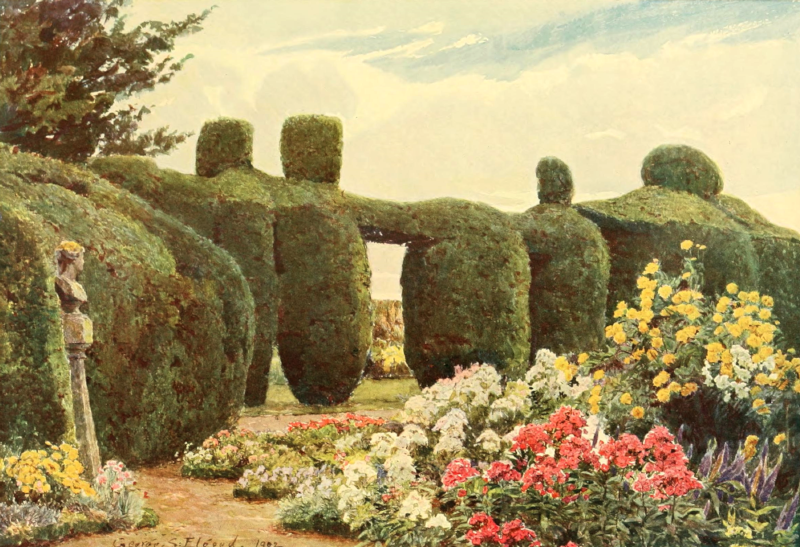| Web
and Book design,
Copyright, Kellscraft Studio 1999-2021 (Return to Web Text-ures) |
 (HOME)
|
|
CAMPSEY
ASHE
In
Eastern Suffolk, within a few miles of the sea, is this, the country home of
the Hon. William Lowther. The
house, replacing an older one that occupied the same site, is of brick and
stone, built in the earlier part of the nineteenth century. A moat, inclosing
an unusually large area, and formerly entirely encompassing the house and
garden, is now partly filled up; but one long arm remains, running the greater
part of the length of the house and garden; a shorter length bounding the
inclosed garden on the opposite side. The longer length of moat approaches the
house closely on its eastern face, and then forms the boundary of a large and
beautifully-kept square lawn, with fine old cedars and other trees. Following
this southward is a double walled garden, with the main paths, especially those
of the nearer division, bordered with flowers. Beyond these again is the
portion of the garden that forms the subject of the picture — a small parterre
of box-edged beds with a row of old clipped yews beyond. This leads westward to
a grove of trees, with a statue also girt with trees standing in an oval in the
midmost space. The
garden has beautiful incidents in abundance, but is somewhat bewildering.
Traces of the older gardening constantly appear; but their original cohesion
has been lost. The moat, always an important feature, ends suddenly at four
points. Garden-houses and gazebos, that usually come at salient points with
determinate effect, seem to have strayed into their places. Sections of the
park seem to have broken loose and lost themselves in the garden. The garden is
not the less charming in detail, but is impossible to gather together or hold
in a clear mental grasp, from the absence of general plan. Besides
the old clipped yews in the picture, others, apparently of the same age,
inclose an oval bowling-green. In form they are as if they had been at first
cut as a thick hedge with a roof-like sloping top. From this, at fairly regular
intervals, spring great rounded masses, that, with the varying vigour of the
individual trees and the continual clipping without reference to a fixed
design, have asserted themselves after their own fashion. Though symmetry has
been lost, the place has gained in pictorial value. Four ways lead in; the
larger bosses guarding the entrances. So it
is throughout this charming but puzzling garden. Ever a glimpse of some
delightful old-world incident, and then the baffled effort to fit together the
disjointed members of what must once have been a definite design. The
portion of the garden that is simplest and clearest is a broad walk opposite
the house, on the further side of the moat, and raised some ten feet above it; backed
by an old yew hedge some twenty feet high, of irregular outline. Just opposite
the middle of the house the line of the hedge is interrupted to give a view
into the park, with a vista between groups of fine elms; but the hedge
stretches away southward the whole length of the long arm of the moat and the
walled gardens. At regular intervals along the old hedge are ranged, on
column-shaped pedestals, busts that came from an Italian villa. About half way
along steps lead down to the moat, where there is a ferry-punt propelled by an
endless rope, such as is commonly used in the fenlands. At the end of the long
walk is a curious seat with a high carved back, that looks as if it had once formed
part of an old ship or state barge, in the bygone days of two hundred years
ago, when a fine style of bold and free wood-carving was lavishly used about
their raised poops and stern-galleries. Towards
the end of the second division of the walled garden is an old orangery or large
garden house, that probably was in connexion with the scheme of the yew hedges.
It has the usual piercing with large lights but no top-light. The original
purpose of these buildings was the housing of orange and other tender trees in
tubs, and the fact of its presence might possibly throw some light on the
mystery of the garden's former planning. Good
hardy flowers are everywhere in abundance. Specially beautiful in the later
summer is a grand pink Hollyhock of strong free habit, with the flowers of that
best of all shapes— with wide, frilled outer petals and centres not too tightly
packed. It
would be interesting work for some one with a knowledge of the garden design of
the past three centuries in England to try to reconstruct the original plan of
some one time. Though on the ground the various remaining portions of the older
work cannot be pieced together, yet, if these were put on paper to proper
scale, it might be possible to come to some general conclusions as to the way
in which the garden was originally, and again perhaps subsequently, laid out. Some
of the remaining portions of the older work of quite different dates may now
seem to be of the same age, but the expert would probably be able to
discriminate. The result of such a study would be worth having even if actual
reconstruction were not contemplated.  THE YEW HEDGE, CAMPSEY ASHE from the picture in the possession of Mr. H. W. Search |